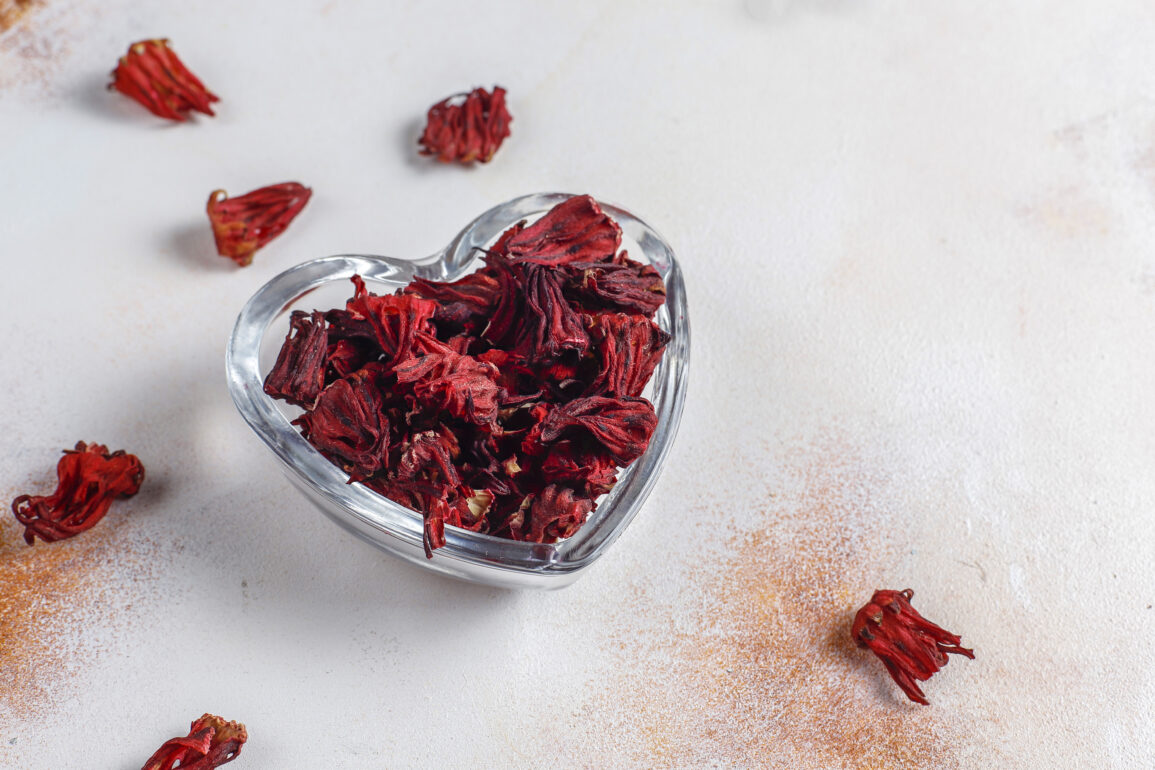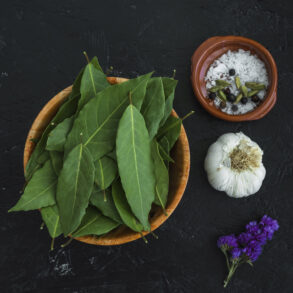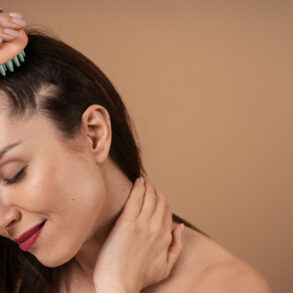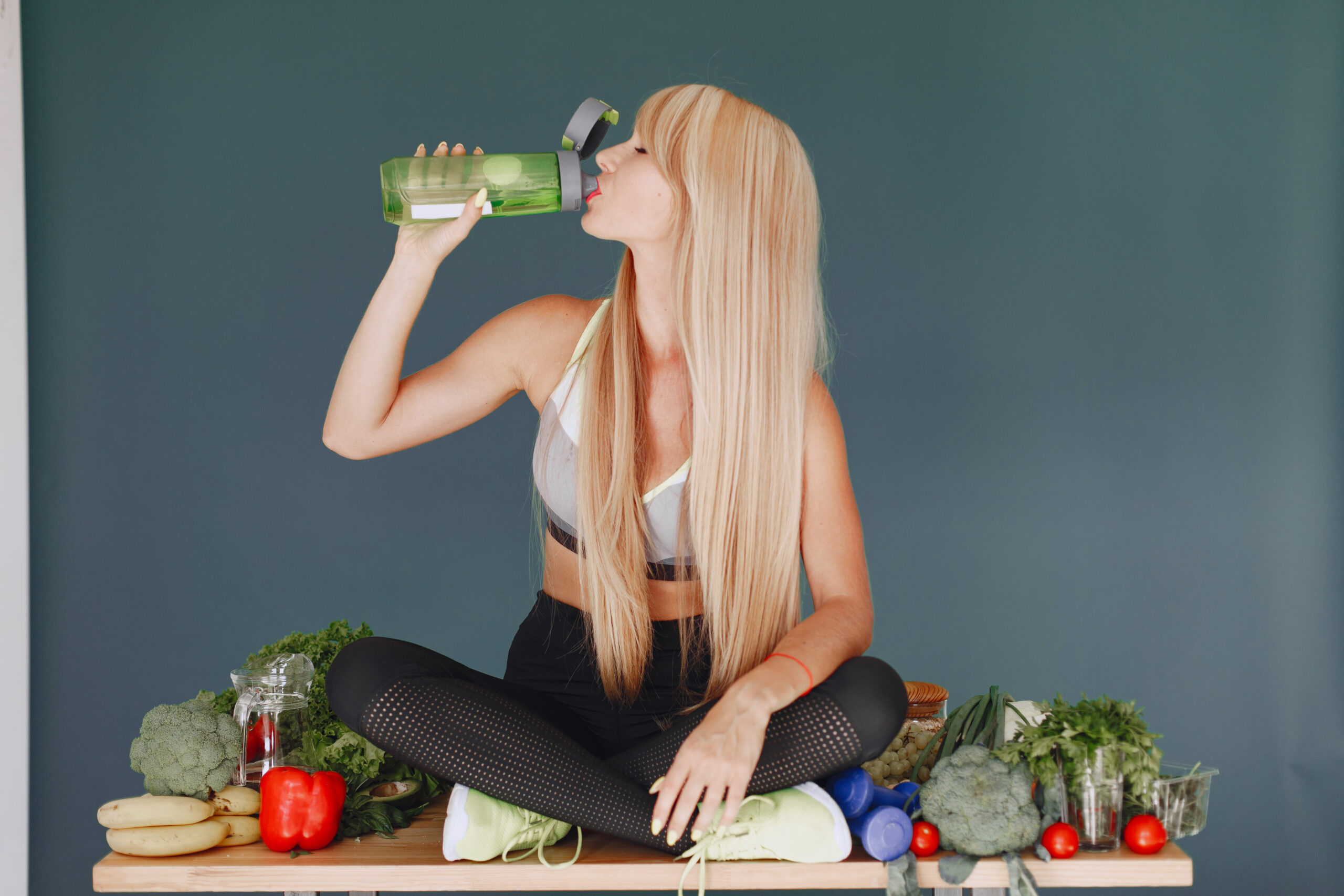Few natural ingredients rival the beauty secret hidden inside the scarlet petals of the hibiscus flower. For centuries, women across tropical regions have relied on hibiscus for shiny hair. They use its petals and leaves to craft nourishing oils, masks, and rinses that transform brittle strands into silk. In Ayurvedic and traditional hair-care rituals, hibiscus is known as the flower of hair care. This is a natural conditioner, growth stimulant, and shine enhancer all in one.
Today, as more people shift toward herbal solutions and chemical-free routines, the world is rediscovering this vibrant flower. Modern science now supports what ancient beauty traditions already knew: using hibiscus for shiny hair can deeply moisturize the scalp, balance oil production, repair damage, and leave hair gleaming with a healthy, mirror-like shine.
1. Why Choose Hibiscus for Shiny Hair?
When hair loses its shine, it usually means the cuticle layer, which is the protective outer shell—is rough, dehydrated, or coated with residue. Hibiscus comes to the rescue with its unique mix of natural acids, vitamins, and amino acids that smooth the cuticle and restore luminosity.
Nutrient Profile of Hibiscus
- Vitamin C: Encourages collagen production for stronger hair.
- Amino Acids: Rebuild the keratin structure that gives hair elasticity.
- Alpha Hydroxy Acids (AHAs): Gently exfoliate the scalp to remove dulling buildup.
- Mucilage: A natural plant emollient that provides slip and softness.
- Flavonoids and Anthocyanins: Powerful antioxidants that fight oxidative stress and dullness.
Because of this blend, using hibiscus for shiny hair nourishes both scalp and strands, sealing in moisture while protecting from pollution and heat.
2. The Ayurvedic Wisdom Behind Hibiscus for Shiny Hair
In Ayurveda, hibiscus is called Japa Pushpa or Jaswandh. It’s categorized as a Keshya herb—one that directly promotes healthy hair. Traditional Ayurvedic texts describe hibiscus as cooling, rejuvenating, and tridosha-balancing, meaning it suits all scalp types.
Ayurvedic Benefits
- Balances Pitta: Reduces excess heat that causes premature greying and dullness.
- Stimulates Kapha: Encourages moisture and luster in dry hair.
- Soothes Vata: Prevents frizz and breakage by increasing nourishment.
For centuries, Ayurvedic practitioners have combined hibiscus petals with coconut oil, amla, and fenugreek seeds to make restorative tonics. Regular massage with these herbal oils is believed to awaken dormant follicles and bring back natural sheen, proving why Ayurveda has long trusted hibiscus for shiny hair.
3. How Hibiscus Enhances Dull Hair
The secret to hibiscus’s shine-boosting magic lies in its chemistry. Here’s what happens when you apply it regularly:
- Smooths Hair Cuticles:
The mild natural acids in hibiscus close raised cuticles, allowing light to reflect evenly across the surface. This gives hair a luminous gloss. - Improves Blood Circulation:
When used in scalp massages, hibiscus increases blood flow to hair follicles, ensuring better oxygen and nutrient delivery. - Restores Moisture:
The mucilage content acts like a natural conditioner, trapping moisture in the strands. - Cleans Without Stripping:
Hibiscus petals contain gentle saponins that cleanse dirt and oil while leaving natural moisture intact—perfect for people who want gentle cleansing along with shine. - Protects Against Damage:
Antioxidants defend hair from UV damage and pollution, two major causes of dullness.
Over time, consistent use of hibiscus for shiny hair transforms lacklustre strands into smooth, radiant locks that gleam even without styling products.
4. Hibiscus Types Used for Hair
There’s more than one way to harness the benefits of hibiscus for shiny hair. You can use fresh petals, dried powder, or ready-made oils depending on convenience and hair type.
a. Fresh Hibiscus Flowers
Crush petals into a fine paste with a few drops of water or coconut oil. This fresh mask gives instant softness and visible shine after just one use.
b. Dried Hibiscus Powder
Perfect for year-round use, the powder retains nutrients when stored correctly. Mix it with yogurt, aloe vera gel, or herbal teas for a quick shine-boosting treatment.
c. Hibiscus Oil
Prepared by infusing petals in carrier oils such as coconut or sesame, hibiscus oil is a staple in South-Indian hair care. Massaging this oil improves circulation and deep-conditions dull hair.
d. Hibiscus Rinse or Tea
A simple herbal rinse made by boiling hibiscus petals in water adds a subtle red tint and glossy finish. It’s a lightweight option for those who prefer water-based treatments.
Each method makes hibiscus for shiny hair accessible and adaptable to modern lifestyles.
5. Step-by-Step DIY Masks and Oils
Let’s explore some easy, proven recipes to use hibiscus for shiny hair at home.
1. Hibiscus and Coconut Oil Glossing Treatment
Ingredients:
- 8 fresh hibiscus petals
- 5 tablespoons coconut oil
Method:
Crush petals and simmer them in coconut oil until the flowers darken. Cool, strain, and massage onto the scalp and hair. Leave overnight and wash with a mild shampoo.
Why It Works:
Coconut oil penetrates deeply, while hibiscus coats the strands with nutrients, leaving an immediate shine.
2. Hibiscus and Aloe Vera Mask
Ingredients:
- 2 tablespoons hibiscus powder
- 3 tablespoons aloe vera gel
- 1 tablespoon yogurt
Method:
Mix into a creamy paste, apply from roots to tips, leave for 30 minutes, then rinse with lukewarm water.
Result:
Aloe’s enzymes smooth cuticles while hibiscus restores lost luster, proving why many swear by hibiscus for shiny hair after a single use.
3. Hibiscus and Amla Strength Pack
Ingredients:
- 2 tablespoons hibiscus powder
- 1 tablespoon amla powder
- Enough water to form a paste
Apply to damp hair, leave for 40 minutes, and rinse. Amla adds Vitamin C and depth of color, enhancing glossiness.
4. Hibiscus and Fenugreek Shine Mask
Fenugreek seeds add protein and reduce dandruff, enhancing hibiscus’s brightening effect.
Method: Soak a tablespoon of fenugreek overnight, grind with hibiscus petals into a smooth paste, and apply weekly.
5. Hibiscus Tea Rinse
Brew a cup of hibiscus tea, let it cool, and pour it over clean hair as a final rinse. It closes the cuticle layer and adds a subtle rosy sheen. This quick trick showcases the instant magic of hibiscus for shiny hair.
6. Scientific Evidence Supporting Hibiscus for Shiny Hair
While tradition praises hibiscus, modern studies also confirm its benefits.
- Hair-Growth and Conditioning Effects:
A 2003 study in the Journal of Ethnopharmacology found that hibiscus leaf extracts promoted hair growth comparable to synthetic growth agents, while improving gloss and texture. - Antioxidant Protection:
Hibiscus contains anthocyanins—antioxidants that protect hair from oxidative stress caused by pollution and UV radiation, major culprits of dull hair. - Natural Surfactants:
Research shows hibiscus petals contain saponins that gently cleanse without stripping natural oils, keeping strands naturally shiny. - Protein Preservation:
Laboratory analysis reveals that hibiscus reduces protein loss in hair fibers, preserving structural integrity and luster.
Science thus supports the traditional claim that hibiscus for shiny hair is more than folklore—it’s biology in action.
7. How Often Should You Use Hibiscus?
Consistency is everything. Using hibiscus for shiny hair two to three times a week provides visible results within a month.
- For Dry Hair: Apply oil or masks twice a week.
- For Oily Hair: Use hibiscus tea rinse after every shampoo.
- For Normal Hair: Alternate between oiling and masks weekly.
Long-term users often notice not only increased shine but also reduced split ends and smoother texture.
8. Pairing Hibiscus with Other Herbs for Extra Shine
In Ayurveda, herbs are rarely used alone. Combining hibiscus for shiny hair with other botanicals amplifies its effects.
| Herb | Role | How It Helps |
|---|---|---|
| Amla (Indian Gooseberry) | Vitamin C source | Enhances gloss and prevents greying |
| Brahmi | Calming herb | Strengthens roots and reduces frizz |
| Neem | Antibacterial | Keeps scalp clear and reflective |
| Bhringraj | Hair tonic | Adds depth and sheen |
| Rose Petals | Aromatic softener | Improves texture and shine |
Creating blends keeps your routine fresh while maximizing the beautifying impact of hibiscus for shiny hair.
9. The Role of Diet and Lifestyle
External care alone isn’t enough. Shine starts from within. To make the most of hibiscus for shiny hair, pair it with a nutrient-rich diet and healthy habits.
Nutrition Tips
- Protein: Eggs, lentils, tofu.
- Iron & Zinc: Spinach, pumpkin seeds, almonds.
- Omega-3s: Flaxseeds, walnuts, and fish.
- Hydration: Drink plenty of water and herbal teas.
Lifestyle Habits
- Sleep 7–8 hours to support regeneration.
- Avoid harsh heat styling and chemical dyes.
- Massage your scalp regularly to boost circulation.
A holistic lifestyle enhances the external glow created by hibiscus for shiny hair treatments.
10. Common Mistakes to Avoid
Even natural remedies can go wrong if misused. Keep these points in mind:
- Using Undiluted Extracts: Highly concentrated hibiscus can stain hair red; dilute it with water or oil.
- Over-Shampooing: Frequent washing strips away hibiscus’s moisturizing film.
- Skipping Conditioner: Though hibiscus is conditioning, extremely dry hair still needs a follow-up conditioner.
- Poor Quality Powder: Always choose pure, chemical-free hibiscus powder; adulterated versions may contain dyes.
- Inconsistency: Sporadic use won’t deliver results—regularity is key to glowing results from hibiscus for shiny hair.
11. Hibiscus for Shiny Hair by Hair Type
While hibiscus is a universal ingredient, different hair types respond uniquely. Adapting its application ensures you get the best possible shine and nourishment.
1. For Dry, Damaged Hair
Dryness dulls shine because the cuticle layer cracks and reflects light unevenly. Hibiscus helps by coating each strand in natural emollients.
- Best Form: Hibiscus-infused coconut or almond oil.
- How to Use: Massage warm oil twice a week and leave overnight.
- Bonus Tip: Mix with aloe vera to enhance softness.
You’ll notice your hair looking glossier and smoother after just two weeks of regular use.
2. For Oily Hair
Excess scalp oil often makes hair limp and greasy rather than shiny. Hibiscus balances sebum production without stripping natural moisture.
- Best Form: Hibiscus tea rinse or hibiscus-lemon mask.
- How to Use: Apply after shampooing; rinse thoroughly.
- Pro Tip: Avoid using heavy hibiscus oils—light, water-based formulations work better.
3. For Curly or Coarse Hair
Curly hair tends to lose shine because it’s harder for natural oils to travel down the strands.
- Best Form: Hibiscus oil mixed with castor or argan oil.
- Routine: Apply oil from roots to tips before washing and follow with a hibiscus conditioner.
- Result: Defined, bouncy curls with visible luster.
4. For Fine or Thin Hair
Fine hair needs shine without weight.
- Best Form: Diluted hibiscus tea spray.
- Routine: Spray lightly on damp hair and style.
- Result: Instant gloss without greasiness.
Tailoring hibiscus for shiny hair treatments according to your texture ensures balanced hydration and a healthy glow.
12. Hibiscus Oil: The Liquid Gloss
Among all hibiscus preparations, oiling remains the most traditional and effective. Hibiscus oil isn’t just another cosmetic product—it’s a complete hair treatment.
How Hibiscus Oil Works
When massaged into the scalp, hibiscus oil penetrates the follicle layer, stimulating new growth while forming a reflective layer that enhances shine. Regular oiling also improves elasticity, preventing breakage and split ends that dull hair’s appearance.
DIY Hibiscus Shine Oil Recipe
Ingredients:
- 10 hibiscus petals
- 5 hibiscus leaves
- 1 cup coconut oil or sesame oil
Preparation:
Crush petals and leaves, then add them to warm coconut oil. Simmer for 10 minutes until the oil turns deep red. Strain and store in a glass bottle.
Application:
Massage warm oil into your scalp twice weekly. Leave overnight and rinse with herbal shampoo.
Why It Works
Coconut oil carries hibiscus’s nutrients deep into the hair shaft. Together, they provide a natural gloss treatment far safer than commercial silicone serums.
Users consistently report that using hibiscus for shiny hair in oil form not only boosts shine but also strengthens roots and softens texture.
13. Hibiscus Shampoo and Conditioner: A Natural Shine Duo
If you prefer simplicity, replace your commercial hair products with hibiscus-based alternatives. Many organic brands now offer shampoos infused with hibiscus extract, but making your own ensures purity.
Homemade Hibiscus Shampoo
Ingredients:
- 10 hibiscus petals
- 5 hibiscus leaves
- 2 tablespoons aloe vera gel
- 1 cup water
Method:
Boil petals and leaves in water for 10 minutes, strain, and add aloe vera gel. Use as a gentle shampoo.
Benefits:
It removes oil buildup while keeping hair glossy and hydrated. Continuous use amplifies the reflective shine effect associated with hibiscus for shiny hair.
Homemade Hibiscus Conditioner
Ingredients:
- 2 tablespoons hibiscus paste
- 1 tablespoon yogurt
- 1 teaspoon honey
Mix well and apply after shampooing. Leave for 10 minutes before rinsing.
Result:
Ultra-soft, detangled, and shiny strands without chemical residues.
14. Hibiscus for Shiny Hair and Color Enhancement
Did you know hibiscus can also enhance your hair’s natural hue? The flower contains plant pigments that subtly tint hair, adding richness and dimension.
1. Natural Red Tint
Red or dark pink hibiscus flowers impart a faint burgundy tone that makes dark hair appear richer.
2. Color Sealant
If you color your hair, hibiscus helps seal pigments, making the dye last longer while adding gloss.
3. Preventing Premature Greying
Hibiscus contains antioxidants that delay greying by reducing oxidative stress on follicles, preserving your hair’s natural sheen.
Thus, hibiscus for shiny hair doubles as a natural color enhancer, deepening tones without any synthetic dye.
15. Hibiscus and Scalp Health: The Foundation of Shine
A healthy scalp is the foundation of shiny hair. Dandruff, itchiness, or clogged follicles can all cause dullness. Hibiscus helps by purifying and balancing the scalp ecosystem.
1. Anti-Dandruff Action
The mild antifungal properties of hibiscus eliminate dandruff-causing microbes, keeping the scalp clean and reflective.
2. Cooling and Soothing Effect
Hibiscus naturally cools the scalp, reducing irritation and redness. A calm scalp equals healthier follicles and brighter strands.
3. Balancing Sebum
Whether your scalp is too dry or too oily, hibiscus normalizes oil production, promoting an even sheen along the hair shaft.
When your scalp thrives, your hair automatically radiates health, proving again the deep connection between scalp vitality and hibiscus for shiny hair.
16. Hibiscus for Men and Women: A Universal Remedy
While often marketed toward women, hibiscus is equally beneficial for men. Its gentle cleansing and strengthening effects work on all hair types.
For Women
- Adds shine and smoothness to long or chemically treated hair.
- Reduces frizz and increases manageability.
- Combats hormonal hair dullness during pregnancy or menopause.
For Men
- Strengthens thinning hair and adds volume.
- Prevents scalp buildup from sweat or pollution.
- Adds a natural, healthy sheen without styling products.
The versatility of hibiscus for shiny hair makes it suitable for the whole family, from children to adults.
17. Modern Research and Innovation
The beauty industry is embracing hibiscus like never before. Modern formulations now use cold-pressed hibiscus oil, encapsulated hibiscus extracts, and bio-fermented hibiscus serums.
1. Cold-Pressed Hibiscus Oil
This extraction method retains more nutrients than heat-based infusions, ensuring maximum shine benefits.
2. Fermented Hibiscus Extracts
Fermentation enhances nutrient bioavailability, making the compounds easier for hair to absorb.
3. Hibiscus in Hair Serums
Lightweight serums infused with hibiscus provide an instant glossy finish while delivering antioxidants to the scalp.
Even cosmetic scientists agree that the consistent results from hibiscus for shiny hair make it one of the most promising natural alternatives to silicones and synthetic gloss boosters.
18. Environmental Benefits of Using Hibiscus
Choosing hibiscus for shiny hair isn’t just good for your beauty—it’s good for the planet. Unlike conventional products loaded with microplastics and synthetic surfactants, hibiscus treatments are biodegradable and eco-friendly.
Sustainability Highlights
- Hibiscus plants require minimal water and thrive without pesticides.
- Every part of the plant—flower, leaf, stem—can be used, minimizing waste.
- Homemade preparations reduce plastic packaging waste.
By turning to natural remedies like hibiscus, you’re contributing to a cleaner environment while enjoying glossy, healthy hair.
19. FAQs About Hibiscus for Shiny Hair
1. How often should I use hibiscus for shiny hair?
Two to three times a week for oils or masks, and daily if using hibiscus water as a rinse.
2. Can I use hibiscus if I have colored hair?
Yes, it’s safe and even helps prolong color life by sealing cuticles.
3. Does hibiscus make hair red?
Only slightly—and usually only if your hair is very light or grey. The tint washes away after a few rinses.
4. Can hibiscus cause hair loss?
No. In fact, it strengthens roots and reduces breakage. However, use fresh or pure powder—chemical additives may cause irritation.
5. Can I store hibiscus preparations?
Fresh masks should be used immediately, while oils last up to three months if kept in a cool, dark place.
6. Does hibiscus work for frizzy or curly hair?
Yes! Its mucilage smooths curls and adds definition, making hair glossy and manageable.
7. Can I mix hibiscus with shampoo?
You can blend a tablespoon of hibiscus powder into mild herbal shampoo to add shine with every wash.
8. Is hibiscus safe for sensitive scalps?
Generally yes, but perform a patch test first, especially with concentrated extracts.
20. The Ultimate Hibiscus Hair Routine for Mirror-Like Shine
To fully experience the power of hibiscus for shiny hair, follow this simple weekly plan:
Day 1: Hibiscus Oil Massage
Warm hibiscus oil and massage into the scalp for 10 minutes. Leave overnight.
Day 2: Cleansing and Conditioning
Wash with a gentle hibiscus shampoo and finish with the hibiscus-yogurt conditioner.
Day 3: Rest Day
Avoid heavy products. Let your hair breathe.
Day 4: Hibiscus Tea Rinse
Brew fresh hibiscus tea and use as a post-shampoo rinse for a natural sheen.
Day 5: Nourishing Mask
Apply a hibiscus-aloe mask to restore hydration and boost glow.
Day 6–7: Repeat Oil Massage
End your week with a soothing scalp massage to maintain blood flow and radiance.
Follow this routine consistently, and in four weeks you’ll see a dramatic improvement in texture and light reflection.
21. Common Myths About Hibiscus for Shiny Hair
Despite its growing popularity, misconceptions persist. Let’s clear a few:
Myth 1: Hibiscus only adds color, not shine.
Truth: The gloss comes from hibiscus’s natural acids and mucilage, which seal cuticles—not from its pigment.
Myth 2: Hibiscus is only for women.
Truth: It benefits all genders equally by nourishing the scalp and promoting a healthy sheen.
Myth 3: Using hibiscus daily can damage hair.
Truth: Pure hibiscus is gentle enough for daily use when properly diluted.
Myth 4: Hibiscus must be used fresh to work.
Truth: Dried hibiscus powder or oil retains most nutrients and is equally effective.
Dispelling these myths encourages more people to embrace hibiscus for shiny hair without hesitation.
22. Long-Term Benefits of Using Hibiscus for Shiny Hair
Unlike chemical gloss serums that give temporary effects, hibiscus builds long-term hair health.
1. Strengthened Roots
Regular application improves follicle health and reduces hair fall.
2. Enhanced Natural Shine
Over time, hibiscus restores lost luster from within the hair fiber.
3. Reduced Split Ends
Its moisturizing ability prevents dryness at the tips.
4. Improved Elasticity
Hair becomes more flexible and less prone to breakage.
5. Youthful Scalp
Antioxidants fight premature ageing of hair follicles.
These cumulative effects explain why traditional beauty routines have always trusted hibiscus for shiny hair as a lifelong companion, not just a quick fix.
23. Conclusion: The Timeless Power of Hibiscus for Shiny Hair
The journey of the hibiscus flower—from temple offerings in India to herbal shampoos in global beauty aisles—reflects its timeless value. This simple flower holds everything your hair needs: nourishment, hydration, balance, and shine.
By embracing hibiscus for shiny hair, you’re not just choosing a natural remedy; you’re adopting an ancient ritual of self-care rooted in respect for nature. Whether used as an oil, mask, or rinse, hibiscus has the power to turn dull, tired hair into strands that shimmer with health and vitality.
If your goal is radiant, silky hair without harsh chemicals, let hibiscus be your go-to botanical ally. With patience, consistency, and love, you’ll soon find your hair reflecting the same brilliance as the vibrant hibiscus petals themselves.










